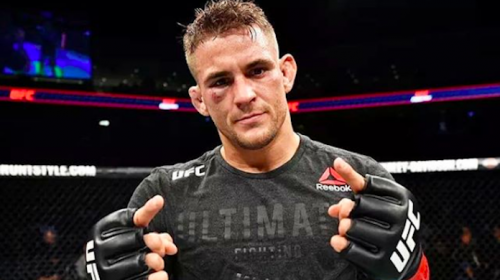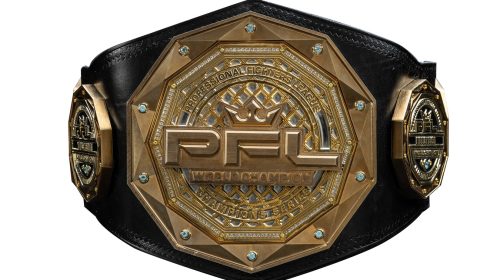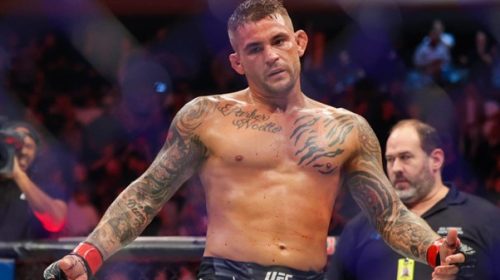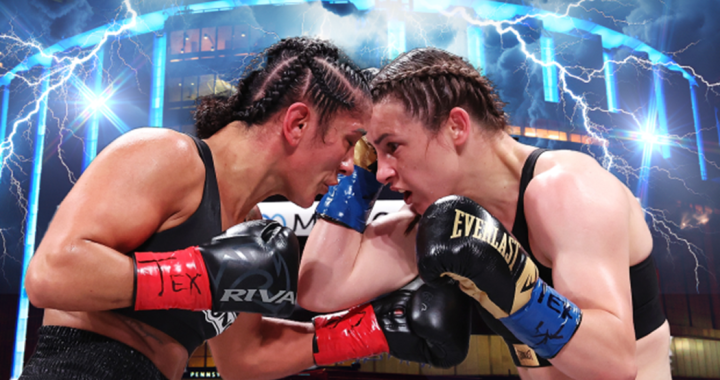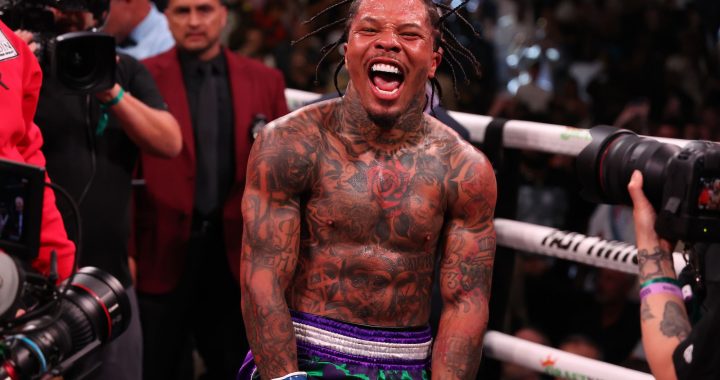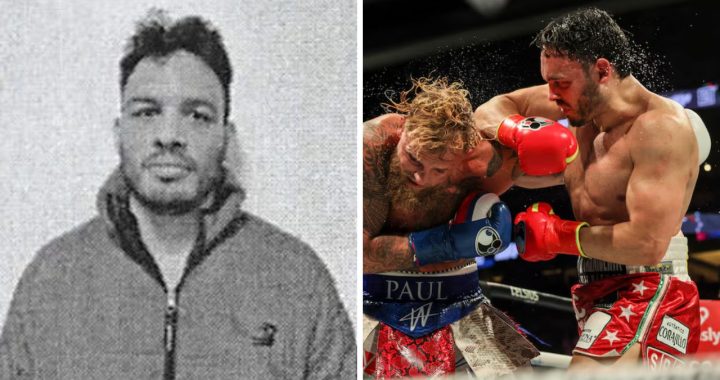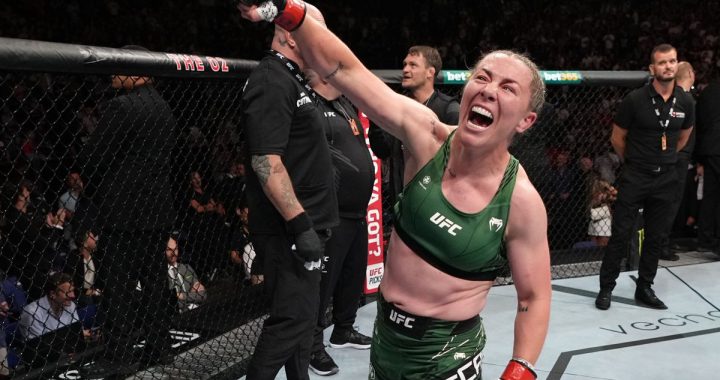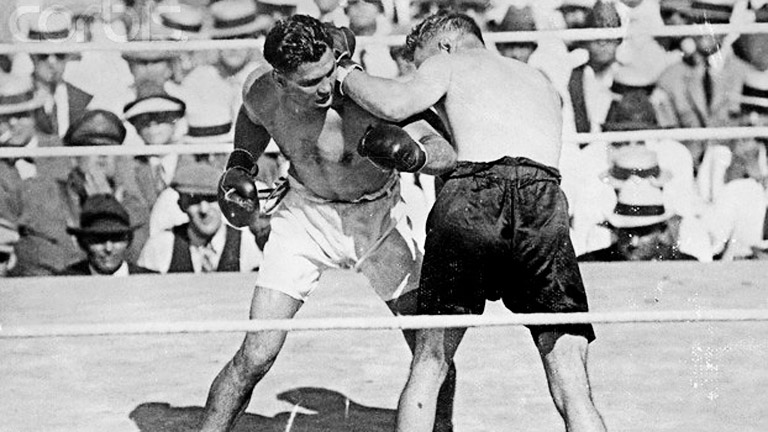
Boxing Across the Nation: Colorado-Boxing’s First Mega-Star Jack Dempsey
Boxing Across the Nation: Colorado – Jack Dempsey
Boxing has been apart of the American sports scene since the 1700s by way of England. It started by infiltrating the larger port towns before eventually working its way into the lexicon of America. Boxing started as an illegal sport which saw it’s athletes arrested. Now it showcases some of the most talented combat sports athletes in the world. We will embark on a 50 part saga exploring the best boxers representing the United States. Some states will have more athletes to choose from than others but the journey will be quite the ride. Let’s embark on the journey looking at an interesting fighter from each state.
Check out the five states we have covered by clicking below:
Alaska-Hector Camacho vs John Montes Card
Arizona-Hall of Famer Michael Carbajal
Arkansas-The Tragic Story of Sonny Liston
California-The Underappreciated Career of Andre Ward
We have made it to the sixth state in our 50 part series (covering in alphabetical order), Colorado. The state is the 21st most populated state in the United States. Though home to such boxers as Denver Ed Martin and former WBO light welterweight champion Mike Alvarado, one name and one city comes to mind when the boxing world thinks of Colorado: Manassa. A town with a population under 1,000 according to the 2010 census, the town has few businesses and no traffic lights or traffic signs. What it lacks in population and economics, it makes hold all the riches in the world when it comes to being the home town to one of the greatest heavyweights of all time, Jack Dempsey.
Early Life and Finding Boxing
Growing Up and Riding the Rails
Born William Harrison Dempsey on June 24, 1895, in Manassa, Colorado, Dempsey was one of 10 children born to a poor family in Colorado. The family would move from Colorado to West Virginia before settling in Utah. Dropping out of school at the elementary level, Dempsey started working at a very young age before eventually fending for himself starting at age 16. He often traveled from hobo camp to camp by way of riding the gears underneath trains. “As for riding the rods, sometimes it got real cold under the train,” Dempsey stated in the book The Boxing Scene page 114. “You’d be hanging on with your eyes shut to avoid the hot blinding cinders and trying and trying to keep warm at the same time. It wasn’t easy especially when exhaustion set in.”
The name “Jack Dempsey” is based on a late 1800’s middleweight world champion named Jack Dempsey. In the book A Flame of Pure Fire: Jack Dempsey and the Roaring 20’s, Dempsey stated all of his brothers and himself wanted the name “Jack Dempsey.” He said they all fought for the name and since he could beat them all and was the toughest, he earned the first name “Jack.”His older brother Bernie used the name “Jack” for a while but as you will soon read, that would change quickly.
Kid Blackie
Dempsey began fighting in bars and saloons for money under the name “Kid Blackie” starting around the age of 16. Many of Dempsey’s early “bouts” were not documented as he either went by the name “Kid Blackie” or “Young Dempsey” in Salt Lake City and any small Colorado town with a saloon and a man looking for a brawler. He would walk into the saloon and say, “I can’t sing and I can’t dance but I can lick anyone in here.” Dempsey often received laughs from the men inside with his high pitched voice sounding like a tough guy.
Beginning of the Documented Career
It is believed Dempsey began to use the “Jack Dempsey” moniker in the fall of 1914, per Nat Fleischer. Fleischer is the founder and editor of The Ring magazine. The magazine was created in 1922 and Fleischer remained the editor-in-chief until his death in 1972. Each year The Ring would produce The Ring Record Book and one of these editions is where Fleischer recounts the following story. Dempsey’s older brother, Bernie, used the name “Jack Dempsey” during his boxing days and was set for a bout with former sparring partner of the former world champion Jack Johnson, by the name of George Copelin.
The switch of a lifetime would be pulled when Bernie decided he wouldn’t be able to take on Copelin and substituted his brother, the smaller William Harrison. Very angered by the switch conspired by the Dempsey brothers, the promoter allowed the bout to go on. After dropping Copelin several times throughout the first couple of rounds, Dempsey ended up taking a seventh-round victory. From this point on Dempsey began to earn more and more for his “bouts” and gain more and more popularity.
The Not So Great “Big Apple”
After defeating Bob York by knockout in Utah on May 30, 1916, Dempsey ventured East with Jack Price, a manager he met around Christmas 1915. At one point Dempsey as Price, “How much money you got?” Price stated he had about $200 which was about what Dempsey had. “Let’s go to New York. Let’s make some real money,” Dempsey told Price. Price reluctantly agreed but told Dempsey he wasn’t riding the rods. “Riding the rods” meant to ride on the undercarriage of the train on the brake beams, which was a dangerous and potentially deadly adventure. Dempsey told Price they would ride plush and stop off along the way, fighting the biggest and badest fighters along the way to make a quick buck.
The two finally made their way into New York City. While Price made the tour with press clippings to local promoters to secure Dempsey a fight, Dempsey took to training at Grupp’s Gym. Money was extremely tight so Dempsey’s meals mostly consisted of a nickel beer, pickles, crackers, and cheese. In order just to get by, Dempsey would shower at the gym and sleep on park benches in Central Park. Weighing about 162lbs, Dempsey took on Andre Anderson on June 24, 1916, Dempsey’s birthday. Anderson entered the bout about 210lbs, nearly 50lbs heavier than Dempsey.
Dempsey won the bout according to the writers. Dempsey’s share of the purse was nine dollars. Prior to judges being used, the media would decide the winners of bouts. Ned Brown of the Morning World based out of Dallas stated, “Dempsey is a young, great fighter. There is one thing wrong with him, however. He looks like he needs a square meal.”
Continuing the East Coast Tour
About two weeks after the Anderson fight, Dempsey was back in the Fairmont Athletic Club in the Bronx fighting against Bert Kenny. Every press-member gave Dempsey the victory and finally, the boxing world took notice of the presence of Dempsey. Once Dempsey’s notoriety began to climb, a fight enthusiast by the name of John Reisler produced a fake telegram to Price stating, “Come home to Salt Lake City at once. Mother gravely ill.” Reisler stated he would take care of Dempsey for Price while he handled his affairs back West.
Wanting to make as much money as possible off of Dempsey, Reisler tried to setup a match between Dempsey and Sam Langford. Dempsey stated he was not ready for a challenger of that caliber yet and refused the bout. In actuality, Reisler was also the manager of Langford and would score double the profit if he could have made the matchup. Dempsey ended up being matched up against John Lester Johnson just six days after the Kenny bout. Dempsey stated the hardest shot he ever took was from Johnson in this bout. Johnson landed a hard right hook during the bout which fractured three of Dempsey’s ribs. After Dempsey was worked by Reisler on the financial end of the business, Dempsey only ended up with 35 dollars. Dempsey stated to himself, “This comes out to ten bucks for each broken rib and two-fifty for each black eye.”
Head Down Headed Home and the Westward Movement
With this, the East Coast experiment was done. Dempsey traveled back West to Salt Lake City, as broke as he left. Before leaving for New York, Dempsey met a prostitute named Maxine Cates. Upon returning from New York, Dempsey had returned a shell of himself and fell for the charm of the woman 15 years his elder. Thinking he could make Cates change her ways and leave the world she was living, he learned he would not be able to do so. In Early 1917, still working hard to provide for himself and his new wife, Dempsey took a bout where he sustained his first “loss”. This would come to “Fireman” Jim Flynn.
Many have speculated for a century that Dempsey took the first round dive in desperate need of the cash to support himself and his new wife. Due to newspapers not going onto microfilm until the 1930s, it’s extremely difficult to find accurate accounts of the event. The Pueblo Colorado Chieftain stated, “Jack Dempsey of Salt Lake was knocked out in 10 seconds after the men shook hands. Flynn pushed Dempsey’s guard with his right arm and swung with his left to the jaw. The Salt Lake man sank to his knees and over for the count and it was 20 seconds after Flynn was declared the winner before Dempsey regained his feet.” Fleischer even mentioned in a 1929 book he wrote on Dempsey, Jack Dempsey: The Idol of Fistiana, he heard from insider talk the bout was fixed.
Chicago Tribune Investigation
In 1920 the Chicago Tribune released a block of articles in what would later become known popularly as “investigative reporting.” One of the articles covered the Dempsey/Flynn bout. The writer whose identification was kept a secret spoke to several people at the event. One of those spoken to was Hardy Downing who was a local boxing promoter and owned a gym.
Downing told the reporter Dempsey told him after the fight, “I’ll fight for you for nothing; I want to square myself here. I always had to figure on money for the folks, and probably I done things I ought to not done but when she needed the money I figured I had to get it some way.” Al Auerbach, Dempsey’s manager at the time, stated Dempsey told him some time after the bout, “I’ll tell you Al, if I had my life to live over I’d never do that thing again.”
The Hobo and the Swindler
Two more different people couldn’t have been more successful than Dempsey and Kearns. Legend has it, Kearns was involved in a bar fight in New York City with Dempsey coming to the rescue. Others say Kearns saw Dempsey fight in New York City in 1916 and was enamored with his power. At the time, Dempsey had roughly 30 professional bouts under his belt and was not even a sparkle in the eye of the public or the heavyweight title. Kearns at this point was a retired fighter of allegedly 60 professional fights.
Kearns led quite the life even before meeting up with Dempsey. When he was around 14 years old Kearns stowed away to the Yukon to mine for gold. After returning from mining he served as a ranch hand and at one point, played minor-league baseball, and even helped smuggle Chinese immigrants to the United States. Dempsey had the tools, but Kearns had the tools to refine those tools and make sure Dempsey never had to ride the rods ever again. Kearns would also set Dempsey on the track to the world heavyweight championship.
From March 1917 to April 1919, Dempsey went on a tear across the country, perfecting his skills and growing his name in the boxing world. Dempsey reeled off 39 fights in this time frame while opponent 40 had only one bout in that time frame. Number 40 would take place on July 04, 1919, against the heavyweight champion of the world, Jess Willard.
Claiming the World Heavyweight Championship
July 04, 1919, the nation’s 143rd birthday, Dempsey received the fruit of all his labors, a world heavyweight title shot against the 6’6″ 235lbs “Pottawatomie Giant” in Jess Willard. Dempsey walked into the Bay View Park Arena of Toledo, Ohio giving up about six inches in height and nearly 50lbs in weight. Walking into the ring at 34 years of age, Willard stood as the favorite to retain his title against the much younger 23-year-old Jack Dempsey with 6:5 odds. The first bell rang at 4:09 pm in the blistering ringside heat of 110 degrees. The event was built to be the biggest event ever with 300 carpenters using 1.75 million feet of lumber to construct the stadium. It was also scaled as the biggest outdoor bout in over 10 years. The event was staged by the huge prizefighting promoter, “Tex” Rickard.
Getting Ready for Fight Night
Rickard was looking for a challenger that could dethrone the “aging” Willard and a man he could promote to big money. In walks Dempsey. At the time Dempsey was 23 years old and improving with every bout. Up to this point, Dempsey had already scored 44 knockouts within his 54 wins. Not only was Dempsey powerful, but he was becoming a boxer, not just your typical bar-fighting slugger. Learning how to play the game, Dempsey even arrived in Toledo around May to work on garnering the affection of the public and the media.
So why Toledo and not a number of any other huge cities known for hosting the nation’s top boxing matchups? At that exact time in history, many states would not allow bouts to go past 10 rounds and also allowed no judging. The huge boxing city considered at the end of the day was New Orleans. Rickard decided to go away from New Orleans because he expected the weather to be unbearable in the South in July. Toledo worked out well because of the railway system, it’s location, and it’s the willingness to fork out money. The City of Toledo leaders took on some of the expenses and even leveled the 60-acre area Rickard needed for his wooden open-air arena.
The Day That Changed Everything in the Heavyweight Division
The time has come. The fans start to fill the handmade stadium but not at the volume hoped for by Rickard. The stadium would only fill to less than a quarter of it’s at least 80,000 capacity, housing 19,500 onlookers. All of the $60 ringside seats and most of the $50 tier tickets sold. The issue came with the $10 general seating area where only 5,000 of the potential 40,000 were sold. Still, with almost 20,000 piled together in July, the ringside temperature measured 110 degrees. Several in attendance complained due to the extreme heat, it caused the trees’ sap to leak out onto their nice suits.
Fight Time
To add to the already mounting pressure, Dempsey’s manager, Kearns, stated he bet their share of the purse on Dempsey to win via first-round knockout. A 10:1 prop bet existed for Dempsey to win via first-round knockout. In a literal “David vs Goliath” matchup, Dempsey stood across from his foe waiting for the bell to ring….and waiting. Timekeeper William Warren Barbour started the stopwatch and pulled the cord for the bell but no sound emitted. The fighters stood staring at each other not sure what to do. Barbour blew a whistle about ten seconds later but did not reset the clock. That could have made a huge difference in Dempsey’s bid to win that prop bet, dropping Willard seven times in round one. A feat that would never be allowed to be duplicated in today’s age of sport. Robbing Dempsey of ten seconds could have made a huge difference.
Referee Ollie Pecord was at the count of “seven” when Barbour blew his whistle to stop the round. Not being able to hear due to the wild crowd, Pecord continued to count Willard down and told Dempsey he was the winner. Dempsey had already started taking the champion’s stroll down the aisle to the back when Barbour was finally able to inform Pecord that Willard was saved by the bell. Dempsey was retrieved and returned to the ring for round two of action.
Rounds two and three were just as bad a beating for Willard as the first round. After the third round concluded Willard’s corner stopped the beating thus making Dempsey the new heavyweight champion of the world. Willard was infamously quoted as saying while he sobbed on a seat in the corner, “I have $100,000 and a farm in Kansas…I have $100,000 and a farm in Kansas.”
Loaded Gloves Accusation
Pulling off his alleged “last dirty trick” as often called, before his passing, Doc Kearns had a memoir written. The memoir was set to release around September 1964, over a year after his passing. A portion of the memoir was “leaked” to Sports Illustrated (January 13, 1964 edition) assembly with the intention to spike sales upon release. 45 years after the “incident,” Kearns claimed Dempsey used “loaded gloves” in the Willard knockout for the championship.
The term “loaded gloves” refers to any type of illegal matter being placed in the glove. The intention is to provide an unfair advantage. Kearns claimed he placed Plaster of Paris on the hand tape of Dempsey without his knowledge. Upon getting wet, Plaster of Paris hardens into an extremely useful, and illegal, aid to knockout someone. In a following edition of Sports Illustrated, Dempsey refutes the accusation by stating Kearns had a vendetta against him and had been fired by Dempsey for owing him over $200,000.
Putting the issue to bed, Nat Fleischer, who was backstage before the event started, “Jack Dempsey had no loaded gloves and no plaster of Paris over his bandages. I watched the proceedings and the only person who had anything to do with the taping of Jack’s hands was Deforest. Kearns had nothing to do with it, so his plaster of Paris story is simply not true.” Even boxing historian and actor JJ Johnston stated in the footage you can see Willard walk over to Dempsey prior to being gloved up, looking at the hand wraps, and then allowing Dempsey’s gloves to be placed on him.
Enjoying the Fruits of Being the World Champion and a Few Tunes up to the Fight of the Century
Dempsey took about 14 months off before returning to the ring for his first title defense. He stayed busy though making the world tour making special appearances as the world champion. He even began the start of his movie career which spanned over 22 films in which Dempsey is credited. The silent film Daredevil Jack premiered prior to Dempsey returning to the ring. It was finally time to return to the ring, the place that brought him the fame he now basks in. His opponent for his return would be Billy Miske, making it their third encounter.
Third Bout with Miske
11,346 fans backed the Floyd Fitzsimmons Arena in Benton Harbor Michigan for Dempsey/Miske III on September 06, 1920. This also marked another monumental moment not only for Dempsey but for sports in general. The Dempsey/Miske III bout was the first to be broadcasted via radio. Billy Miske had met Dempsey on two previous occasions, losing both by decision. In round three Dempsey put the finishing shots to Miske and won via third-round TKO. At the time of the bout, Miske was battling with Bright’s Disease, known to cause inflammation in the kidneys. Dempsey would later go on to say, “During the fight, I began to feel that Billy wasn’t giving me as tough a battle as I expected. He did not seem like his old self.”
Dempsey Rocks Madison Square Garden…and Bill Brennan
In what the July 1964 edition of Boxing Illustrated called “Dempsey’s toughest fight,” Demspey defended the title a little over three months after knocking out Miske in Michigan. This time the opponent was Bill Brennan where about 13,000 fans watched inside Madison Square Garden. The December 15, 1920 edition of the Quebec Telegraph stated Brennan was unafraid of the champion but that, “the champion proved to be Brennan’s master in nearly every stage of the bout.” The two met in 1918 in Milwaukee, Wisconsin where Dempsey knocked out Brennan in the sixth round. On this night Brennan would prove to be a much tougher task. Dempsey was still able to score a knockout. It took Dempsey 12 rounds this time but finally scored the KO. The stage was set for boxing’s first million-dollar gate and one of the golden age of sports most golden moments.
Leadup to Boxing’s First Million Dollar Gate: Dempsey vs Carpentier
Deemed the “Fight of the Century” Dempsey’s title defense against the French light heavyweight champion of the world, Georges Carpentier would serve as a huge monumental moment in the sport of boxing. The Dempsey/Carpentier bout, which took place on July 02, 1921, earned the sport’s first million-dollar gate bringing in $1,789,238. Adjusted for inflation as of 2020, that’s a gate over $25 million. Heading into the bout, Dempsey was viewed as the villain while Carpentier was revered as the hero. This was due in part to Dempsey not fighting in World War I. Carpentier, on the other hand, was a member of the French Army as a pilot.
A Stadium All For Itself
Envisioning a crowd much larger than Madison Square Garden could facilitate, promoter Tex Rickard borrowed $250,ooo to build “Boyle’s Thirty Acres” in New Jersey. The stadium was a large wooden bowl built to hold about 80,000 fans in what was being dubbed the “Fight of the Century.” 2.25 million feet of lumber was used to construct the mammoth building which spanned seven acres. The bowl would go on to host several more title fights before being deconstructed in 1927 and currently stands as the grounds for adult housing.
Fight of the Century
The 20 squared foot ring welcomed the main event fighters at 3:16 pm with Dempsey as the 2:1 betting favorite. Another important momentous moment to this bout was it’s the first bout sanctioned by the National Boxing Association. The NBA would later become known as the World Boxing Association (WBA) in 1964. The July 02, 1921 edition of the St. Petersburg Times stated nearly $200,000 (about $2.8 million today) was placed on fight night in betting money per Wall Street. In total, about $500,000 was believed to have been bet on the fight.
As expected, Dempsey came out pushing the pace early. Dempsey ate a hard shot in the second round but as expected kept pressing forward damaging Carpentier which each strike. Less than a minute into the fourth round, Dempsey landed a vicious combo that dropped Carpentier. He was able to be the ten count, just barely, getting up at nine. Less than a minute later, Dempsey bout the finishing touches on Carpentier landing another combo that Carpentier could not defeat. Dempsey was the winner in the sports’s first “million-dollar gate.”
Ending Career with a Final Four of Bouts
The Historic Luis Firpo Bout
Dempsey’s final bout as world champion victor would come on September 14, 1923. The 80,000+ fans packed the Polo Grounds of New York City. His opponent for that night would be the former South American Heavyweight champion, Argentinian Luis Angel Firpo. Firpo was more than a formidable opponent with victories over big names. He defeated former world champ Jess Willard, Bill Brennan, and twice over Gunboat Smith. Firpo also earned the distinction of becoming the first Latin American to ever challenge for the world title.
A Moment Portrayed in Art Forever
In a feat that would never be duplicated in today’s age of boxing, Dempsey floored Firpo seven times. With less than a minute left, Firpo unleashed a ravenous attack that knocked Dempsey feet-over-head out of the ring. On the way out, Dempsey hit his head on a press member’s typewriter. Around 17 seconds into the count Dempsey was helped into the ring. On a complete knockout of the ring, a fighter is given a 20 count to re-enter. The vision of Dempsey being knocked out of the ring was painted by George Bellows in 1923. The oil canvas piece sits at the Whiney Museum of Art and has been apart of their collection since the museum opened in 1931. The artist actually painted himself into the painting at the bottom left with members of the press.
In the second round, Firpo was throwing big, labored strikes that just could not reach the champion. Dempsey was able to floor the challenger and regain his confidence. No more than a few seconds after returning to his feet, Carpentier was dropped again, and again for the third time. After the third knockout, Carpentier could not beat the ten count of referee Johnny Gallagher.
After the bout, Dempsey stated, “It was the first time I was knocked down since I became champion and I’ll never forget it. I saw eight million stars when I got that punch on the chin that knocked me out of the ring. I didn’t even know he had knocked me out of the ring until I came to on my stool between rounds and thought I had been knocked out.” Both fighters rose to instant stardom beyond their current standings with the bout historian Burt Sugar would call the greatest fight in the history of the sport.
Time Off Before Gene Tunney I
From the time of the Firpo bout until his next defense against sophisticated, Greenwich, Connecticut born Gene Tunney, three years would pass. Dempsey was far from taking a break during those three years. He spent much of the time traveling the world doing exhibitions and appeared in films. Rumors have circulated Dempsey was offered a bout with Harry Wills, but it was declined. Dempsey would also go on to marry actress Estelle Taylor and fire Doc Kearns. Kearns would go on to repeatedly sue Dempsey over “money due.” In September 1926, it was finally time for Dempsey to return to the ring. It would be Dempsey’s last day as the champ.
First Bout with Gene Tunney
The bout ended up taking place on September 23, 1926. A record-breaking crowd of 120,577 packed inside the Sesquicentennial Stadium in Philadelphia. Back on the Harry Wills theory, the Dempsey/Tunney bout was scheduled for September 16 at Yankee Stadium but the New York State Athletic Commission required Dempsey to defend the title against Wills first. The bout went on as scheduled, but a week later and in a whole different state. That attendance record would stand for 67 years until Julio Cesar Chavez met Greg Haugen in Mexico City in February 1993.
Dempsey was the favorite although he was coming off of a three-year layoff. Heading into the Dempsey bout, Tunney had an impressive 80-1-4 record. As the fighter’s entered the ring, it started to rain, an ominous sign for one Jack Dempsey. The Herald-Journal September 23, 1926 edition gave a round-by-round breakdown discussing the ten round dominating performance of the boxer Tunney. In the locker room after the fight, Dempsey famously told his wife, “Honey, I forgot to Duck.” Then-president Ronald Reagan would tell his wife the same thing after he was shot in an assassination attempt of his life. Brian Tuohy discussed in his book Larceny Games: Sports Gambling, Game Fixing, and the FBI a rumor surrounding the idea of Dempsey being poisoned before his bout.
Was There A Setup?
Daily, Jack Dempsey drank a small amount of olive oil to help is digestion. Many speculate his bodyguard, Mike Trent, was paid off to poison Dempsey. The believed culprit was Arnold Rothstein who had a $125,000 bet ($1.8 million in 2020) on a Tunney victory at 4:1 odds. Rothstein was also connected to the White Sox throwing the 1919 World Series in baseball. He would also become a mentor to many of New York’s future crime bosses.
Sharkey Bout and Retirement Bout with Tunney
The Final Victory: Jack Sharkey
Internally Dempsey was thinking it was time to retire. He decided to give it one more run. In order to get back at Tunney for a title shot, he would have to defeat Jack Sharkey. July 21, 1927, in Yankee Stadium in front of around 82,000 fans, Dempsey would drop Sharkey with a left hook for a seventh-round TKO. Not without controversy, Sharkey looked at the referee to complain about a low blow at which time Dempsey clocked Sharkey with a left. Up until the knockout, Sharkey was ahead in the bout. In a pre-bout poll of 25 writers, only nine selected Dempsey would walk out with the win.
The Rematch with Tunney
On September 22, 1927, two months after the Sharkey bout, the time had come for Dempsey to get his chance to regain his world title from Tunney. A six-figure crowd (104,943) packed Soldiers Field in Chicago for the sports’s first two-million-dollar gate. Racketeers and mobsters out in full force, Rothstein is yet allegedly associated with this bout again claimed to have offered Tunney one million dollars, along with Abe Attell, to throw the fight for a Dempsey win. Al Capone was said to be in the mix as well, allegedly involved in trying to bribe a referee. The referee was changed prior to the bout.
A recent rule change by the Illinois State Athletic Commission would be to Dempsey’s detriment. In the seventh round, Dempsey knocked down Tunney and he rushed to stand aside Tunney waiting for him to stand. In those days there was not a standing eight count. It took the referee several seconds to get Dempsey to go to a neutral corner. The ten count would not start until this happened. At the count of nine Tunney was able to rise to his feet. The incident would infamously become known as The Long Count. Tunney would go on to win by unanimous decision again, retaining his world title. Dempsey would insist after the bout that Tunney was down for 14 seconds in the seventh round. In February of the following year, Jack Dempsey announced his official retirement from the sport of boxing.
Life After Boxing and Legacy
“I’m the best ever. There’s never been anybody as ruthless. I’m Sonny Liston, I’m Jack Dempsey. There’s no one like me. I’m cut from their cloth.” -Mike Tyson after the Lou Savarese bout in 2000. 80 years after his last bout and Dempsey’s name came out of the mouth of arguably the sports’s most ruthless, aggressive fighter ever in Mike Tyson. Tyson even mimicked Dempsy’s “hobo haircut” in one of his bouts. Aside from his influence on boxers of the future, Dempsey would continue his movie career. He even entered World War II. After criticism for not joining the military in World War I, Dempsey vowed to not make the same mistake twice.
In 1954, Jack Dempsey was an inaugural member of The Ring’s Hall of Fame. Also, Dempsey was an inaugural 1990 inductee into the International Boxing Hall of Fame. Dempsey lived to the old age of 87 where he passed away on May 31, 1983, due to heart failure. Dempsey was one of the first boxers to use an aggressive style. He had the personality to be the sport’s first true mega-star.
